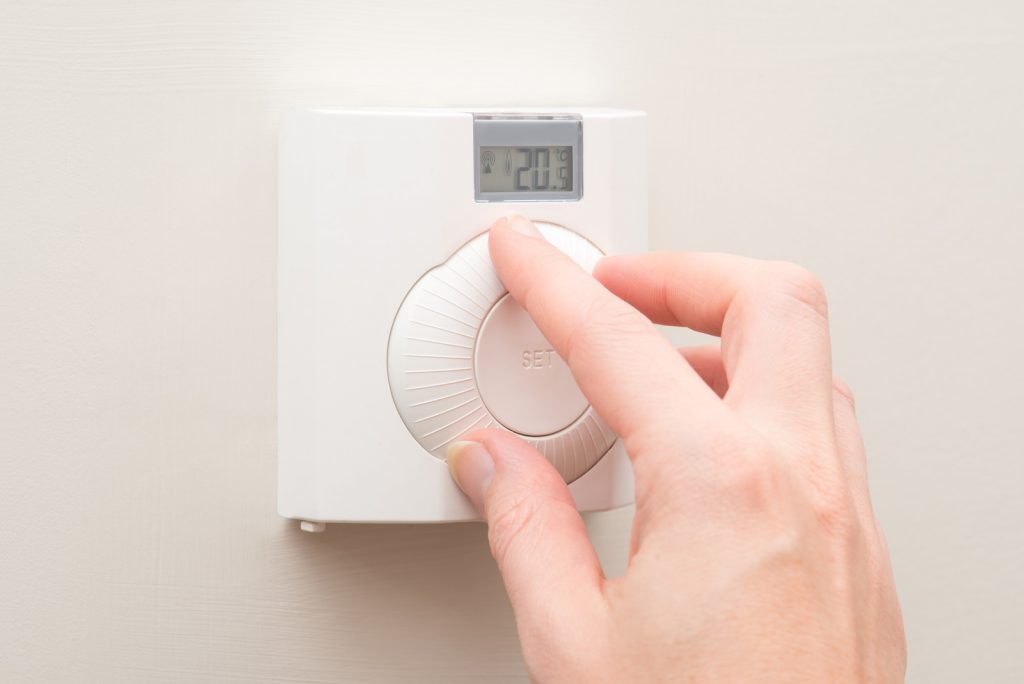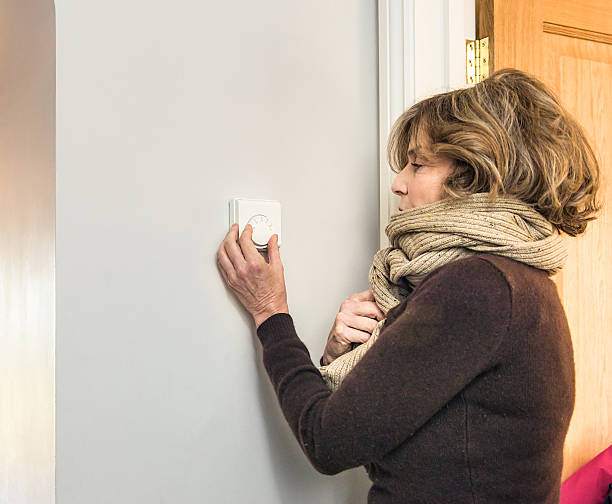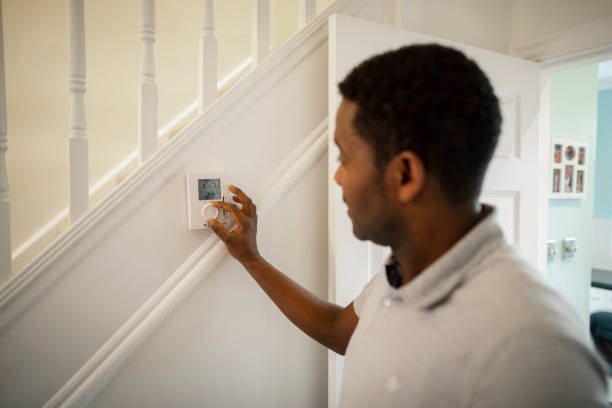
Are you struggling to find the perfect spot to install your room thermostat? Finding the best location for this crucial device is essential in maintaining a comfortable and energy-efficient home.
In this article, we’ll explore why proper thermostat placement matters, factors to consider when choosing an ideal location, common installation mistakes to avoid, and some top recommendations for getting it right.
Key Takeaways
- The proper location of a room thermostat is crucial for accurate temperature control and energy efficiency.
- Choosing an area close to where people spend most of their time – such as living rooms or hallways, away from direct sunlight and heat sources ensures optimal performance.
- Proper insulation, ventilation, and avoiding drafts through sealings contribute significantly towards efficient temperature regulation throughout your home.
- Thermostats should be mounted around 5 feet above the ground level on an interior wall for better airflow between rooms while maintaining accurate readings regardless of potential interference factors.
The best place to install a room thermostat is typically on an interior wall, away from direct sunlight, draughts and heat sources. It should be centrally located within the main living area for accurate temperature readings and effective control of your heating or cooling system.
Understanding the Role of a Room Thermostat
Before delving into the installation process, let’s first understand the significance of a room thermostat. Acting as the control centre for your heating and cooling system, a room thermostat enables you to set and maintain your desired indoor temperature.
It allows you to achieve a perfect balance between comfort and energy savings by regulating when the system turns on or off. Proper installation plays a vital role in ensuring accurate temperature measurements and efficient operation.
The Importance Of Proper Location For A Room Thermostat
The proper location of a room thermostat is crucial for accurate temperature control and energy efficiency.
Central Location For Accuracy
Selecting the right location for your room thermostat is crucial to achieving accurate temperature readings throughout your home.
For example, imagine you installed your Hive thermostat in a small corner room that receives direct sunlight most of the day; this would cause misleading readings and lead to inefficient energy usage.
By choosing to place the room thermostat in an area close to where people spend most of their time – such as living rooms or hallways – you ensure that the system will work optimally based on real-time changes in occupancy patterns.
Furthermore, installing it at around 5ft off the ground can help capture an even more accurate picture of indoor climate conditions.
Avoiding Interference And Direct Sunlight
To ensure that your room thermostat accurately reflects the temperature of your home, it’s essential to avoid interference and direct sunlight. Placing the thermostat near a window or door can cause drafts or exposure to sunlight, resulting in inaccurate readings.
It’s recommended to choose an interior wall away from potential sources of interference for accurate temperature measurement. Avoid placing the thermostat in rooms with high humidity levels like bathrooms or kitchens as this could affect its performance.

Energy Savings
Installing a room thermostat in the right location can lead to significant energy savings. When your thermostat is located correctly, it accurately detects and regulates the temperature, which reduces wasted heating or cooling energy.
For example, placing the thermostat in direct sunlight or above a heat source will cause it to detect higher temperatures than those of the rest of the house. This inaccurate sensor reading leads to excessive use of air conditioning when not required.
Similarly, installing a thermostat near draaughty windows or doors will mislead the heating system into turning on prematurely and keep running longer than necessary leading to more power wastage.
Improved Comfort And Temperature Control
Proper placement of a room thermostat can significantly enhance your comfort and temperature control at home. By placing it in a frequently used room, you can easily adjust the temperature to your liking without having to walk long distances.
This improved accuracy means that your heating and cooling system will run more efficiently, saving energy and money on utility bills. Additionally, by programming your thermostat according to occupancy patterns and insulation levels, you can maintain consistent temperatures throughout the day without being forced to make manual adjustments constantly.
Extended Lifespan Of The Heating System
Properly locating and installing a room thermostat can lead to several benefits for your central heating system, including an extended lifespan. By ensuring that the thermostat is in a central location and accurately measures the temperature, your heating and cooling systems will not have to work harder than necessary.
In addition to reducing strain on your system, using a programmable thermostat allows you to set schedules for when your heating or air conditioning should turn on/off, meaning you won’t be wasting energy by running them unnecessarily.
This leads to more efficient operation of your system, saving you money on energy bills while also extending its lifespan.
Consistent Use For Energy Efficiency
Consistent use of your room thermostat can lead to significant energy savings and increased efficiency. Setting the temperature to a comfortable level and leaving it at that temperature consistently allows your central heating system to operate more efficiently, reducing energy waste.
Many newer thermostats even have programmable settings available, allowing you to adjust the temperature based on occupancy patterns or time of day.
For example, if you are away from home during the day, adjusting your thermostat to a slightly higher (or lower) temperature setting can help save on heating or cooling costs while still maintaining comfort levels when you return.
Factors To Consider When Choosing The Best Location
Consider the occupancy and usage patterns of the room, as well as insulation and ventilation, and proximity to heat sources when choosing a location for your room thermostat.
Occupancy And Usage Patterns
When deciding on the best location for your room thermostat, it is important to consider the occupancy and usage patterns of your home. The thermostat should be placed in a room that is frequently used and has consistent traffic throughout the day.
You should also consider rooms with high ceilings or large windows as these can affect temperature readings. Rooms with poor insulation or ventilation may require a different approach when determining where to place the thermostat.
Insulation And Ventilation
Proper insulation and ventilation play a crucial role in determining the best location for a room thermostat. When choosing where to place your thermostat, it’s important to consider if the area has good insulation to prevent heat loss or gain.
Areas with poor insulation may affect temperature readings, leading to inaccurate heating or cooling cycles and higher energy bills.
For example, placing a thermostat near an uninsulated exterior wall can cause it to read lower temperatures than in other parts of the house. This could lead the heating system to work more than necessary resulting in unnecessary energy costs.
Therefore, choose an interior wall that is well insulated and properly ventilated when deciding on a suitable location for your thermostat installation.
Close To Heat Sources
It is important to avoid installing your room thermostat near any heat sources, as this can affect the temperature reading and lead to inaccurate control of your heating system.
Heat sources may include radiators, fireplaces or even electronic devices that generate heat.
To ensure accurate readings and efficient energy use, consider placing your thermostat on an interior wall in a space where heat sources are not present.
Additionally, it is worth noting that wireless thermostats provide more flexibility with placement options since they can be installed anywhere in your home without being tethered by wires.
Wi-Fi Capability and Accessibility
With the advent of smart home technology, many thermostats now offer Wi-Fi connectivity, enabling remote access and control through mobile devices. If you opt for a smart thermostat, ensure it is within the range of your Wi-Fi network for seamless operation and convenient adjustments.
Common Mistakes When Installing And Locating A Room Thermostat
Many homeowners make the mistake of placing their thermostat near windows or doors, which can affect the accuracy of temperature readings due to drafts and fluctuating temperatures.
Additionally, installing the thermostat too close to heat sources, such as radiators or fireplaces, can result in inaccurate readings and higher energy bills. Another common error is improper height placement, with thermostats mounted too low or high on a wall leading to incorrect temperature measurements.
Placement Near Windows Or Doors
It is essential to avoid installing a room thermostat near windows or doors as they can interfere with its accuracy. The changing temperatures from drafts and sunlight can cause the thermostat to read an incorrect temperature, leading to inefficient cooling or heating.
For example, if you install your thermostat near a window that receives direct sunlight for most of the day, it may misread the indoor temperature and keep the air conditioning on longer than necessary.
Similarly, placing a thermostat near drafty doors can make it difficult for the system to maintain stable temperatures in your home.
Location Near Heat Sources
It is important to avoid installing a room thermostat near heat sources such as radiators, fireplaces or air vents. Heat sources can impact the accuracy of the temperature reading and lead to inconsistent heating throughout your home.
It’s better to place the thermostat in an area that is not affected by nearby sources of heat, such as an interior wall or hallway away from direct sunlight. Positioning your thermostat in this way will help ensure accurate temperature readings and greater energy efficiency for your heating system, improving overall comfort throughout your home.
Installation In Draughty Areas
It’s important to avoid installing your thermostat in drafty areas, as this can lead to inaccurate temperature readings and wasted energy.
Drafts can occur near windows, doors, or poorly insulated walls.
Instead of placing the thermostat in a drafty area, consider finding a more centralized location that is away from these problem spots. The interior wall of a frequently used room or hallway would be an ideal place for accurate temperature control.
Improper Height
Installing a thermostat at the wrong height can affect its ability to accurately regulate temperature. The most common mistake is to install it too close to the ceiling or floor, where hot and cold air accumulates respectively.
This results in readings that do not reflect the actual temperature of the room. For accurate readings, it is recommended to install the thermostat about 5 feet above the ground level and away from any heat sources.
A recent study revealed that an improperly installed thermostat could cause energy bills to increase by up to 10 percent annually. It’s essential always to seek guidance from professionals before installing your thermostat, especially if you’re unsure about placement options in your property.
Best Locations For Installing A Room Thermostat
The best locations for installing a room thermostat are in the center of the house, frequently occupied rooms, on an interior wall away from direct sunlight and heat sources.
In The Centre Of The House
Placing your room thermostat towards the centre of your home is a great way to achieve accurate temperature control. This position ensures that the thermostat is not affected by drafts or other conditions that may be present near exterior windows and doors.
When installed in this location, you’ll find that your heating system operates more efficiently, saving you money on utility costs in the long run.
For optimal performance, place your thermostat on an interior wall in a room that is most frequently occupied. The hallway is also a good option as it’s typically situated close to all rooms and provides easy accessibility to adjust temperature settings.
Remember, wireless thermostats offer flexibility in placement so you can install them anywhere in your home with ease.
Frequently Occupied Rooms
The best place to install a room thermostat is in a frequently used room such as the living room or bedroom. This ensures that you have easy access to temperature controls and can adjust them for maximum comfort.
You should also consider insulation, ventilation, and proximity to heat sources when choosing where to locate your thermostat. For example, if the living room has large windows that let in sunlight during the day, it’s not an ideal location for a thermostat as it will give inaccurate readings.
It’s important to remember that the position of your thermostat affects energy efficiency and can help extend the lifespan of your system.
Away From Direct Sunlight And Heat Sources
When choosing the best location to install a room thermostat, it is important to avoid direct sunlight and heat sources. Direct exposure to sunlight can cause inaccurate readings of the temperature, leading to inefficient heating or cooling in your home.
Instead, consider installing your thermostat on an interior wall away from any windows or doors that may let in drafts. This will provide a more consistent and accurate reading of the overall temperature in your home.
By taking these factors into account when choosing the location for your room thermostat, you can improve its accuracy and effectiveness while also saving on energy costs.
On An Interior Wall
One of the most important factors to consider when installing a room thermostat is the placement on an interior wall. Interior walls provide more stability in temperature readings, as they are less affected by external temperature changes compared to exterior walls.
Additionally, placing the thermostat on an interior wall can prevent interference from direct sunlight or drafts that may affect its accuracy.
Moreover, it’s essential to ensure that the interior wall selected for installation is among the frequently used rooms in your home for easy accessibility and frequent use.
Remember, accurate reading comes with consistent adjustment of thermostats based on household schedules and occupancy patterns.

Avoid Areas With High Humidity Or Temperature Fluctuations
It is important to avoid installing a room thermostat in areas with high humidity or temperature fluctuations. Humid areas, such as bathrooms and kitchens, can cause inaccurate readings, leading to inefficient heating and cooling of your home.
To ensure accurate temperature control and energy efficiency, it is best to choose a location that experiences consistent temperatures throughout the day.
The middle of the house or frequently used rooms can provide an ideal location for your thermostat installation. Additionally, keeping the thermostat away from heat sources and drafty areas will prevent false readings and improve overall comfort levels in your home.
The Benefits of Professional Installation
While the above steps outline a general installation process, it’s essential to acknowledge the advantages of professional installation services. Qualified heating engineers possess the expertise and experience necessary to ensure an accurate and efficient installation.
They can provide valuable insights into the optimal thermostat placement for your specific home or office layout, guaranteeing optimal comfort and energy savings.
Conclusion
In conclusion, the proper placement and installation of a room thermostat is crucial in ensuring optimal energy efficiency and temperature control. Avoiding direct sunlight, heat sources, and drafty areas are some of the factors to consider.
The ideal location for a thermostat would be in a frequently occupied room towards the center of your property or on an interior wall in the hallway. With smart home technology advancements such as wireless thermostats and home automation, you have more flexibility than ever before in choosing where to place your thermostat.
By following these guidelines for proper installation and location, you can benefit from lower energy bills, improved comfort levels, and an extended lifespan for your heating system.
